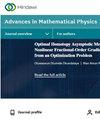基于证据理论的柔性电Timoshenko梁QMU分析
IF 1.1
4区 物理与天体物理
Q3 PHYSICS, MATHEMATICAL
引用次数: 0
摘要
近年来,随着纳米技术的飞速发展,一种类似于压电效应的新型机电耦合效应——挠电效应逐渐进入人们的视野。挠曲电子束作为挠曲电信号输出的主要结构单元,在下一代微纳机电系统中具有广阔的应用前景。因此,研究柔性电材料和结构对柔性电器件的设计具有重要的科学和工程应用意义。本文建立了挠性电Timoshenko梁的模型,将受迫振动的挠度、转角和动态电信号输出作为系统响应,选择密度、剪切修正系数和频率比作为系统的关键性能参数。现有数据和工程师经验的结合表明,参数中存在随机和认知的不确定性。因此,在证据理论的框架下,通过量化边际和不确定性(QMUs)分析方法,用似然函数和信念函数来表示系统性能响应的概率分布,并通过计算得到的置信因子来衡量系统的可靠性或性能评价。这些结果为柔性电气元件的精确分析提供了理论依据,并为设计性能优良的柔性电气元件提供了指导。本文章由计算机程序翻译,如有差异,请以英文原文为准。
QMU Analysis of Flexoelectric Timoshenko Beam by Evidence Theory
In recent years, with the rapid development of nanotechnology, a new type of electromechanical coupling effect similar to the piezoelectric effect, the flexoelectric effect, has gradually come into the public’s view. The flexoelectric beam that is the main structural unit of the flexoelectric signal output has broad application prospects in the next generation of micro- and nanoelectromechanical systems. Therefore, the investigation of flexoelectric materials and structures has important scientific and engineering application significances for the design of flexoelectric devices. In this paper, a model of flexoelectric Timoshenko beam is established, the deflection, rotation angle, and dynamic electrical signal output of the forced vibration are taken as the system response, and the density , shear correction factor , and frequency ratio are selected as the key performance parameters of the system. The combination of available data and engineers’ experience suggests that there are random and cognitive uncertainties in the parameters. Therefore, the probability distribution of the system performance response is expressed by the likelihood function and belief function through the quantification of margins and uncertainties (QMUs) analysis methodology under the framework of evidence theory, and the system reliability or performance evaluation is measured by the calculated confidence factors. These results provide a theoretical basis for accurate analysis of flexoelectric components and provide guidance for the design of flexoelectric components with excellent performance.
求助全文
通过发布文献求助,成功后即可免费获取论文全文。
去求助
来源期刊

Advances in Mathematical Physics
数学-应用数学
CiteScore
2.40
自引率
8.30%
发文量
151
审稿时长
>12 weeks
期刊介绍:
Advances in Mathematical Physics publishes papers that seek to understand mathematical basis of physical phenomena, and solve problems in physics via mathematical approaches. The journal welcomes submissions from mathematical physicists, theoretical physicists, and mathematicians alike.
As well as original research, Advances in Mathematical Physics also publishes focused review articles that examine the state of the art, identify emerging trends, and suggest future directions for developing fields.
 求助内容:
求助内容: 应助结果提醒方式:
应助结果提醒方式:


